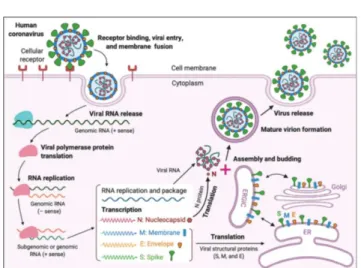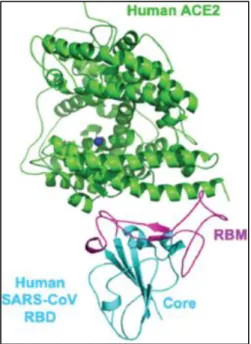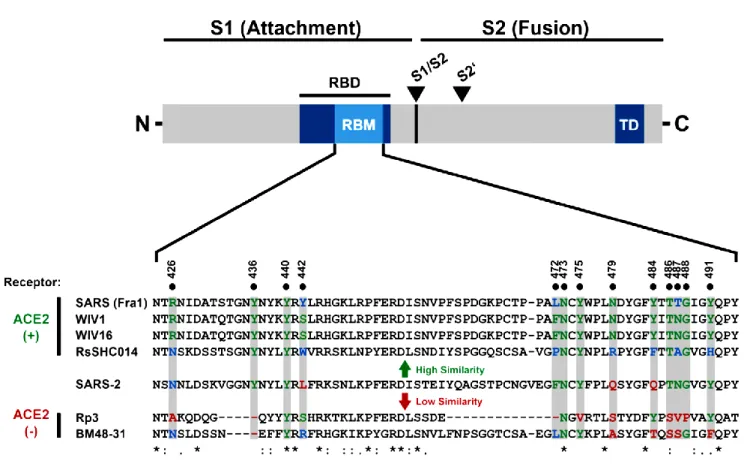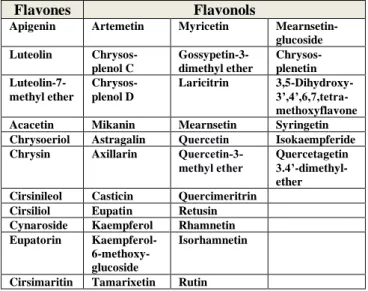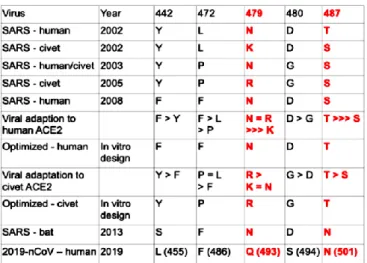E COCYCLES Scientific journal of the
ISSN 2416-2140 European Ecocycles Society
Ecocycles, Vol. 6, No. 2, pp. 38-45 (2020) DOI: 10.19040/ecocycles.v6i2.176
ORIGINAL PAPER
Effective natural food complements: anti-CoV-2 spike protein directed druggable inhibitors
Oláh, Zoltán
1-3*; Ökrész, László
1; Török, Ibolya
1; Pestenácz, Anikó
1; Harkai, Anikó
1; Kocsis, Éva
1-31Acheuron Ltd., Szeged, Hungary 2Forget-Me-Not B2B Ltd., Szeged, Hungary 3 Vásárhely’s Landscaping (VATES) Folks- School Society, Hódmezővásárhely, Hungary
*corresponding author, e-mail: oz@acheuron.com
Abstract – There is a number of photosynthetically produced small molecules that have previously been validated through SARS- CoV spike protein interaction assays for selectivity and effectivity in our database. Our specialty database, the AVIRA-DB, has been built from scientific papers that published results regarding selective & effective CoV-2 spike protein binding inhibitors that prevent virus binding to the Angiotensin Converting Enzyme type 2 (ACE2). These data have been accumulated since 2003, the time of the first well documented coronavirus pandemic. To develop our anti-viral nutraceutical capsule we favoured small molecules (Mw <1000 Dalton) from edible plant parts that are enriched in experimentally evaluated coronavirus inhibitors. From this “AVIRA-DB” we screened for local culture varieties of vegetables and spices that are enriched in the anti-viral hits. Thus, AVIRA is the first knowledge-based nutraceutical composition that was validated by selective anti-CoV-2’s spike protein assays, performed in silico, -vitro & -vivo. From Chemo- & Bio-text-mined meta-data from literature and patents resulted in druggable flavonoids and flavonols, which were validated as anti-CoV-2 spike protein directed small molecules that are preventing the binding of the virus to ACE2.
Keywords – coronavirus, SARS-CoV-2, ACE2, spike protein binding inhibitors, AVIRA, anti-viral nutraceuticals, spike protein assay, druggable flavonoids
Received: April 30, 2020 Accepted: November 17, 2020
INTRODUCTION
In silico chemo-, bio-informatics search for network medicine Severe acute respiratory syndrome coronavirus (SARS-CoV) is the pathogen of SARS, which caused the 1st global panic in 2003 (Poutanen et al., 2003; Tsang et al., 2003). Since this coronavirus pandemics, it is well established that the Angiotensin Converting Enzyme type 2 (ACE2) is primarily used for docking and cellular entry of (+) RNA of SARS- CoV. Furthermore, the spike protein is highly mutable upon jumping from one species to another, including humans (Fig.
1). Systematic literature and patent searches were performed by molecular virologists and biologists in our laboratory for a better understanding of the quantitative Structure Activity Relationships (qSAR) of druggable leads that are capable of destroying interactions of cellular receptor with the spike protein of SARS CoV-2 virus (Chen, Han, Wang, & Zhao, 2020; Messina et al., 2020). Annotation of data of interests
Figure 1. Structural and mechanistic interaction of CoV-2 with the ACE2 virus receptor (Jiang et. al 2020). Source:
https://doi.org/10.1016/j.it.2020.03.007
39
was carried out with systematic and extensive manual text mining before upload in the “AVIRA-DB”. Up till know (2020Q3) more than 1500 texts and tables were checked from patents and peer reviewed journal articles to prepare this overview and the 1st evidence based food supplement, called AVIRA.
MATERIALS AND METHODS
Screening by key words and collection of publications for uploading data into the AVIRA-DB
Figure 2. BioDjinnTM Knowledge Management System The BioDjinnTM proprietary knowledge management and taxonomy system of the Acheuron Ltd (Fig.2) was utilized to upload the AVIRA-DB by curators familiar with the best practices of molecular biology and virology. The PubMed (NLM) has been recently rescreened, to find relevant publications concerning the current coronavirus pandemic, i.e. ACE2 (Nicolau, Noleto, & Medeiros, 2020), spike protein inhibitor (Sinha et al., 2020; Xia et al., 2020), COVID flavonoid (Das, Majumder, Mandal, & Basak, 2020; Ngwa et al., 2020), spike protein assay (Chan et al., 2009; Gniffke et al., 2020; He et al., 2005; Jaimes, Millet, Goldstein, Whittaker, & Straus, 2019; Manopo et al., 2005; Woo et al., 2005; Yan et al., 2007; Zhao et al., 2005) (Table 1.).
Table 1. Number of publications for keywords
Keyword Year of
publication
Number of publications
COVID-19 2003-2020 44916
CoV-2 2003-2020 8010
ACE2 2003-2020 1066
spike protein binding 2003-2020 98 spike protein inhibitor 2020 2
anti-viral 2003-2020 1078
COVID flavonoid 2020 2
Cov-2 inhibitor 2003-2020 53 Spike protein assay 2005-2020 8
To find plant parts that concentrate either in vitro and -vivo spike protein inhibitor assay (i.e. Cov-2 spike protein pseudotyped) (Chan et al., 2009) or clinically tried non-toxic druggable substances the curators also used the proprietary
BioDjinnTM software to upload the AVIRA-DB with previously determined enrichments of bioactive anti-virals’
data.
Typical HT-screening essays for antiviral small molecular leads
Typically, Frontal Affinity Chromatography-Mass Spectrometry (FAC/MS) is employed to screen small molecule libraries from herbs, including Prunella vulgaris and Saussurea lappa Clarks that exhibited antiviral activities, i.e. against HIV-1 (Busschots, De Rijck, Christ, & Debyser, 2009; Chang & Yeung, 1988; Yi et al., 2004; Zeng et al., 2005).
Pseudotyped virus infection assay is preferred to search for drugs that can interfere with the entry of SARS-CoV into host cells
Briefly, inhibitory activities of SARS patients’ sera and selected small molecules against the HIV-luc/SARS pseudotyped virus to enter Vero E6 cells are evaluated by determination of inhibitory activities of sera of SARS-CoV patients. The ability of the SARS patient sera to block the infectivity of HIV-luc/SARS (SARS) vs the absence of such blocking activity in normal serum was noted. Also, the lack of neutralizing activity of the SARS sera against the pseudotyped virus bearing the G protein of Vesicular Stomatitis Virus could infect the target cells at a similar level to that of HIV-luc/SARS.
Nutraceuticals enriched with AVIRA-DB guided anti-viral agents
Figure 3. Overall protein folds of human SARS-CoV core RBD (receptor-binding domain, cyan), and RBM (receptor- binding motif, magenta) in complex with human ACE2 (green) (Source: Wan, Shang, Graham, Baric, & Li, 2020).
The AVIRA herbal food supplement was designed by curators of Acheuron Ltd. employing the BioDjinnTM database platform to upload the AVIRA-DB and evaluate small
40
molecule ingredients anti- CoV-2 spike protein directed druggable inhibitors. The virologist curators looked at identified number of small molecules that bind avidly to the SARS CoV-S2 protein and can interfere with the entry of SARS-CoV into Vero E6 cells, with potent antiviral activities against wild-type SARS-CoV with EC50 values, typically, of the low micro-molar range (Messina et al., 2020).
Grinded plant parts (>300 mm) enriched with experimentally tried BIOFLAVONOIDS that are tried in number of evident- based protocols, selectively bind to the spike protein of CoV- 2 and prevent binding of the Human SARS-CoV S1’s RBD/RBM to ACE2, the cellular receptor counterpart (Fig. 3
& Table 2).
Figure 4. Alignment of the receptor binding motif (RBM) of SARS-S with corresponding sequences of bat-associated betacoronavirus S1 proteins, which reveals that SARS-CoV-2 possesses crucial amino acid residues for ACE2 binding (Hoffmann et al., 2020).
Figure 5. Homologous Macro Domains in SARS-CoV-2 and rubella virus determined by structure-guided sequence alignment using the crystal structure of the SARS-CoV-2 Macro domain bound to ADP ribose as the template (Protein Data Bank entry 6W02) Source: Young et al. 2020 https://doi.org/10.1101/2020.04.10.20053207
41
Preparation of the AVIRA food supplement
The AVIRA-DB has been searched for natural enrichments of small molecules with promising (i.e. Kd in micromolar range) spike protein binding and/or inhibitor substances enrichments in edible plants, vegetables, and spices. A short list was prepared from promising plants that accumulate evidence-based (i.e. Cov-2 spike protein pseudotyped HT- screened) BIOFLAVONOIDS (Table 3) that may fight with COVID infections. Since it is well known that the ACE2, the type2 pro-angiotensin cleaving enzyme is the key receptor of CoV-2 entry (Fig.3), thus, “to maintain and promote a normal blood pressure” (statement of EFSA) cocoa has been also incorporated as source of selective and bioactive FLAVONOLs (Table 2).
Table 2. The most promising bioflavonoids, FLAVONES and FLAVONOLS selected, some of them have already tested in assays specific for Cov-2 spike protein pseudotyped virus displacement.
Flavones Flavonols
Apigenin Artemetin Myricetin Mearnsetin- glucoside Luteolin Chrysos-
plenol C
Gossypetin-3- dimethyl ether
Chrysos- plenetin Luteolin-7-
methyl ether
Chrysos- plenol D
Laricitrin 3,5-Dihydroxy- 3’,4’,6,7,tetra- methoxyflavone Acacetin Mikanin Mearnsetin Syringetin Chrysoeriol Astragalin Quercetin Isokaempferide Chrysin Axillarin Quercetin-3-
methyl ether Quercetagetin 3.4’-dimethyl- ether Cirsinileol Casticin Quercimeritrin Cirsiliol Eupatin Retusin Cynaroside Kaempferol Rhamnetin Eupatorin Kaempferol-
6-methoxy- glucoside
Isorhamnetin
Cirsimaritin Tamarixetin Rutin
RESULTS
The likelihood of recovering replication-competent virus also declines after onset of symptoms. For patients with mild to moderate COVID-19, replication-competent virus has not been recovered after 10 days following symptom onset (CDC, unpublished data, 2020; Wölfel et al., 2020; Arons et al., 2020; Bullard et al., 2020; Lu et al., 2020; personal communication with Young et al., 2020; Korea CDC, 2020).
Recovery of replication-competent virus between 10 and 20 days after symptom onset has been documented in some persons with severe COVID-19 that, in some cases, was complicated by immunocompromised state (van Kampen et al., 2020). However, in this series of patients, it was estimated that 88% and 95% of their specimens no longer yielded replication-competent virus after 10 and 15 days, respectively, following symptom onset.
A large contact tracing study demonstrated that high-risk household and hospital contacts did not develop infection if their exposure to a case patient started 6 days or more after the case patient’s illness onset (Cheng et al., 2020).
Although replication-competent virus was not isolated 3 weeks after symptom onset, recovered patients can continue to have SARS-CoV-2 RNA detected in their upper respiratory specimens for up to 12 weeks (Korea CDC, 2020;
Li et al., 2020; Xiao et al, 2020). Investigation of 285
“persistently positive” persons, which included 126 persons who had developed recurrent symptoms, found no secondary infections among 790 contacts attributable to contact with these case patients. Efforts to isolate replication-competent virus from 108 of these case patients were unsuccessful (Korea CDC, 2020).
Specimens from patients who recovered from an initial COVID-19 illness and subsequently developed new symptoms and retested positive by RT-PCR did not have replication-competent virus detected (Korea CDC, 2020; Lu et al., 2020). The risk of reinfection may be lower in the first 3 months after initial infection, based on limited evidence from another betacoronavirus (HCoV-OC43), the genus to which SARS-CoV-2 belongs (Kiyuka et al, 2018).
Currently, almost a year after the emergence of SARS-CoV- 2, there have been several confirmed cases of SARS-CoV-2 reinfection. However, the number of areas where sustained infection pressure has been maintained, and therefore reinfections would be most likely observed, remains limited.
Serologic or other correlates of immunity have not yet been established.
The current evidence includes the following caveats:
In a recent study of skilled nursing facility workers followed prospectively for asymptomatic infection, one of 48 infected staff had a nasopharyngeal swab which was weakly positive on a single-passage plaque assay more than 20 days after initial diagnosis; however, the specimen was not subjected to serial passage to demonstrate the presence of replication- competent virus (Quicke et al., 2020).
In one case report, a person with mild illness provided specimens that yielded replication-competent virus for up to 18 days after symptom onset (Liu et al., 2020).
Data currently available are derived from adults; equivalent data from children and infants are not presently available.
More data are needed concerning viral shedding in some situations, including in immunocompromised persons.
Concentrations of SARS-CoV-2 RNA measured in upper respiratory specimens decline after onset of symptoms (CDC, unpublished data, 2020; Midgley et al., 2020; Young et al., 2020; Zou et al., 2020; Wölfel et al., 2020; van Kampen et al., 2020).
Phytochemicals that prevent CoV-2 – ACE2 interactions Not only man made hexapeptides i.e. Tyr-Lys-Tyr- Arg-Tyr- Leu, but either bioassay determined or clinically tried Anti- CoV-2 selective flavonoid inhibitors were uploaded in the AVIRA-DB, noted by text mining of the scientific and patent
42
literature since the 1st well documented coronavirus pandemics (Yi et al., 2004). From this repertoire beet (Sawicki et al., 2020), onion (Fuentes et al., 2020; Kwak et al., 2017), parsley leaves (Harrison, 2020), thyme, rosemary.
(Jia et al., 2020; Li et al., 2020; Sun et al., 2020), oregano, cocoa (Balzer et al., 2006), safflower (J. Chen et al., 2020) were chosen with black pepper to promote absorption from the intestine to blood’s plasma. “BIOFLAVONOIDS also support a healthy immune system” (statement of EFSA) in fighting with any viral infection, since ACE2, the type2 pro- angiotensin cleaving enzyme is the key receptor of CoV-2 entry (Fig.3). “To maintain and promote a normal blood pressure” (statement of EFSA) cocoa has been incorporated as source of BIOFLAVONOLs in AVIRA. However, majority of pulverized plant ingredients, such as beet, onion of locally grown (Makó, Hungary Allium cepa var. cepa cv. Makói Bronz), parsley leaves, thyme, rosemary, oregano, and safflower are naturally enriched in POLYPHENOLIC and BIOFLAVONOID substances.
Other phytochemicals have been determined with antiviral activities. Ivy tea was noted to improve acute bronchitis, one of the complications of Cov-2 infection (Bester et al., 2020;
Kruttschnitt et al., 2020).
Repurposing
From patentability point of view, either biotech or pharmaceutical companies, traditionally prefer repurposing prescription drug arsenal for new infective agents (Bester, Burger, & Maree, 2020; Kruttschnitt, Wegener, Zahner, &
Henzen-Bucking, 2020). The most advanced and so far the most successful drug repurposing clinical trial is going on with Remdesivir (RDV) which is a broad-spectrum adenosine triphosphate nucleoside anti-viral analog. It is an investigational small molecule developed by Gilad Sciences Inc. in 2015, primarily for the treatment of Ebola. RDV is in Phase–II trials to interevent Ebola virus-induced hemorrhagic fever (Hoenen, Groseth, & Feldmann, 2019).
Another repurposing human clinical trial is being conducted with Favipiravir (FPV), a derivative of pyrazine carboxamide, is a promising broad-spectrum antiviral drug.
FPV is initially developed for influenza, but also on H1N1, Ebola, Arena, and Bunya viruses. As far as the blocking mechanism is concerned FPV inhibits production of the mature retrovirus by preventing amplification of its genetic material by the viral-dependent polymerase. It has been screened against many RNA viruses. Because of its action against RNA viruses, FPV approved, so far in Japan and France and not in other countries for a few indications (Khambholja & Asudani, 2020). To determine the viability of FPV for COVID-19 repurposing, we carried out a literature survey of clinical trials using FPV as an investigational drug for different indications. Results of the research published for a multi-centric Phase II study showed clinical effectiveness1
1https://clinicaltrials.gov/ct2/show/NCT01068912
2 https://clinicaltrials.gov/ct2/show/NCT02026349
of FPV in influenza in low-dose and high-dose treatment modalities with no mortality and no substantial possibility of severe adverse reactions2
CoV-2 cross reactive vaccines from our childhood?
There are also childhood vaccines that may be cross protective, due to the in silico testable cross-reactive antigenic motif-homology in their viral proteomes (i.e. spike, reverse transcriptase, polymerase etc.) (Fig.4). The recent isolates of highly contagious varieties of the SARS CoV-2, determined with significantly long homologous regions noted in spike proteins of Measles, Mumps and Rubella (MMR).
Especially, the secondary structure alignment of the SARS- CoV-2 Macro domain bound to ADP ribose as the template (Protein Data Bank entry 6W02) showed dramatic (SS)- guided domain sequence homology with the rubella virus Macro domains (Fig.5). However, homology with spike protein of measles and mumps are quite obvious.
Homologous protein domains in SARS-CoV-2 and measles, mumps and rubella viruses provide preliminary evidence that MMR vaccine might be protective against COVID-19 therefore this immunization worth considering to stop the current SARS-CoV-2 pandemics (Sampaio, Rodrigues, Meireles, & Andrade Junior, 2020; Shanker, 2020).
Infusion of anti-Cov-2 selective IgG-antibodies
Recent anti-CoV-2 blood plasma transplantations of recovered CoV-2 (+) tested patients provided the proof-of- principle of safety and efficacy of de novo produced anti- CoV-2 specific IgG antibodies. However, one 0.5 liter plasma transplant rescue only one patient with severe complication that present considerable constraint of the treatment (Sheridan, 2020). Another potential problem is that antibodies in serum of convalescent patients following mild CoV-2 do not always prevent virus receptor binding, either due to the selectivity or efficay of the polyclonal IgG population (Gattinger et al., 2020).
Structural analysis of human ACE2 recognition by 2019- nCoV and SARS-CoVs
All of these five residues of SARS CoVs, (see in Table 3) underwent natural selections and were shown to be critical for ACE2-recognition, cell entry, and host range of SARS-CoV RBM. The residue numbers are shown as in SARS CoV RBD, with the corresponding residue numbers in 2019-nCoV in parentheses (Wan et al., 2020).
DISCUSSION
Available data indicate that persons with mild to moderate COVID-19 remain infectious no longer than 10 days after symptom onset. Persons with more severe to critical illness or severe immunocompromise likely remain infectious no longer than 20 days after symptom onset. Recovered persons can continue to shed detectable SARS-CoV-2 RNA in upper
43
respiratory specimens for up to 3 months after illness onset, albeit at concentrations considerably lower than during illness, in ranges where replication-competent virus has not been reliably recovered and infectiousness is unlikely. The etiology of this persistently detectable SARS-CoV-2 RNA has yet to be determined. Studies have not found evidence that clinically recovered persons with persistence of viral RNA have transmitted SARS-CoV-2 to others. These findings strengthen the justification for relying on a symptom based, rather than test-based strategy for ending isolation of these patients, so that persons who are by current evidence no longer infectious are not kept unnecessarily isolated and excluded from work or other responsibilities.
Table 3. Critical residue changes in the RBMs of SARS-CoV and 2019-nCoV (Wan et al. 2020)
Reinfection with SARS-CoV-2 has been definitively confirmed in recovered persons. If, and if so when, persons can be reinfected with SARS-CoV-2 remains unknown and is a subject of investigation. Persons infected with related endemic human betacoronavirus appear to become susceptible again at around 90 days after onset of infection.
Thus, for persons recovered from SARS-CoV-2 infection, a positive PCR during the 90 days after illness onset more likely represents persistent shedding of viral RNA than reinfection. If such a person remains asymptomatic during this 90-day period, then any re-testing is unlikely to yield useful information, even if the person had close contact with an infected person.
If such a person becomes symptomatic during this 90-day period and an evaluation fails to identify a diagnosis other than SARS-CoV-2 infection (e.g., influenza), then the person may warrant evaluation for SARS-CoV-2 reinfection in consultation with an infectious disease or infection control expert. Isolation may be warranted during this evaluation, particularly if symptoms developed after close contact with an infected person.
CONCLUSIONS
Duration of isolation and precautions
For most persons with COVID-19 illness, isolation and precautions can generally be discontinued 10 days after symptom onset1 and resolution of fever for at least 24 hours, without the use of fever-reducing medications, and with improvement of other symptoms.
A limited number of persons with severe illness may produce replication-competent virus beyond 10 days that may warrant extending duration of isolation and precautions for up to 20 days after symptom onset; consider consultation with infection control experts.
For persons who never develop symptoms, isolation and other precautions can be discontinued 10 days after the date of their first positive RT-PCR test for SARS-CoV-2 RNA.
For all others, a test-based strategy is no longer recommended except to discontinue isolation or precautions earlier than would occur under the strategy outlined in Part 1, above.
Role of PCR testing2 after discontinuation of isolation or precautions
For persons previously diagnosed with symptomatic COVID- 19 who remain asymptomatic after recovery, retesting is not recommended within 3 months after the date of symptom onset for the initial COVID-19 infection.
For persons who develop new symptoms consistent with COVID-19 during the 3 months after the date of initial symptom onset, if an alternative etiology cannot be identified by a provider, then the person may warrant retesting;
consultation with infectious disease or infection control experts is recommended. Isolation may be considered during this evaluation based on consultation with an infection control expert, especially in the event symptoms develop within 14 days after close contact with an infected person. For persons who never developed symptoms, the date of first positive RT-PCR test for SARS-CoV-2 RNA should be used in place of the date of symptom onset.
Role of serologic testing
Serologic testing should not be used to establish the presence or absence of SARS-CoV-2 infection or reinfection.
Correlates of immunity to SARS-CoV-2 infection have not been established. Specifically, the utility of serologic testing to establish the absence or presence of infection or reinfection remains undefined. The recommendations are based on the best information available in mid-July 2020 and reflect the realities of an evolving pandemic. Even for pathogens for which many years of data are available, it may not be possible to establish recommendations that ensure 100% of persons who are shedding replication-competent virus remain isolated. CDC will continue to closely monitor the evolving science for information that would warrant reconsideration of these recommendations.
44
REFERENCESBalzer, J., Heiss, C., Schroeter, H., Brouzos, P., Kleinbongard, P., Matern, S., . . . Kelm, M. (2006). Flavanols and cardiovascular health: effects on the circulating NO pool in humans. J Cardiovasc Pharmacol, 47 Suppl 2, S122-127;
discussion S172-126.
DOI: 10.1097/00005344-200606001-00006
Bester, R., Burger, J. T., & Maree, H. J. (2020). Genomic characterisation of a newly identified badnavirus infecting ivy (Hedera helix). Arch Virol, 165(6), 1511-1514.
DOI: 10.1007/s00705-020-04627-1
Busschots, K., De Rijck, J., Christ, F., & Debyser, Z. (2009).
In search of small molecules blocking interactions between HIV proteins and intracellular cofactors. Mol Biosyst, 5(1), 21-31.
DOI: 10.1039/b810306b
Chang, R. S., & Yeung, H. W. (1988). Inhibition of growth of human immunodeficiency virus in vitro by crude extracts of Chinese medicinal herbs. Antiviral Res, 9(3), 163-175.
DOI: 10.1016/0166-3542(88)90001-0
Chen, J., Wang, J., Wang, R., Xian, B., Ren, C., Liu, Q., Pei, J. (2020). Integrated metabolomics and transcriptome analysis on flavonoid biosynthesis in safflower (Carthamus tinctorius L.) under MeJA treatment. BMC Plant Biol, 20(1), 353.
DOI: 10.1186/s12870-020-02554-6
Chen, X., Han, W., Wang, G., & Zhao, X. (2020). Application prospect of polysaccharides in the development of anti-novel coronavirus drugs and vaccines. Int J Biol Macromol, 164, 331-343.
DOI: 10.1016/j.ijbiomac.2020.07.106
Fuentes, J., Arias-Sante, M. F., Atala, E., Pastene, E., Kogan, M. J., & Speisky, H. (2020). Low nanomolar concentrations of a quercetin oxidation product, which naturally occurs in onion peel, protect cells against oxidative damage. Food Chem, 314, 126166.
DOI: 10.1016/j.foodchem.2020.126166
Gattinger, P., Borochova, K., Dorofeeva, Y., Henning, R., Kiss, R., Kratzer, B., Valenta, R. (2020). Antibodies in serum of convalescent patients following mild COVID-19 do not always prevent virus receptor binding. Allergy (online ahead of print)
DOI: 10.1111/all.14523
Harrison, C. (2020). Drug researchers pursue new lines of attack against COVID-19. Nat Biotechnol, 38(6), 659-662.
DOI: 10.1038/d41587-020-00013-z
Hoffmann, M., Kleine-Weber, H., Schroeder, S., Kruger, N., Herrler, T., Erichsen, S., Pohlmann, S. (2020). SARS-CoV-2 Cell Entry Depends on ACE2 and TMPRSS2 and Is Blocked
by a Clinically Proven Protease Inhibitor. Cell, 181(2), 271- 280 e278. DOI: 10.1016/j.cell.2020.02.052
Jia, S., Guan, T., Zhang, X., Liu, Y., Liu, Y., & Zhao, X.
(2020). Serum metabonomics analysis of quercetin against the toxicity induced by cadmium in rats. J Biochem Mol Toxicol, e22448.
DOI: 10.1002/jbt.22448
Kruttschnitt, E., Wegener, T., Zahner, C., & Henzen- Bucking, S. (2020). Assessment of the Efficacy and Safety of Ivy Leaf (Hedera helix) Cough Syrup Compared with Acetylcysteine in Adults and Children with Acute Bronchitis.
Evid Based Complement Alternat Med, 2020, 1910656.
DOI: 10.1155/2020/1910656
Kwak, J. H., Seo, J. M., Kim, N. H., Arasu, M. V., Kim, S., Yoon, M. K., & Kim, S. J. (2017). Variation of quercetin glycoside derivatives in three onion (Allium cepa L.) varieties. Saudi J Biol Sci, 24(6), 1387-1391.
DOI: 10.1016/j.sjbs.2016.05.014
Li, S. S., Cao, H., Shen, D. Z., Chen, C., Xing, S. L., Dou, F.
F., & Jia, Q. L. (2020). Effect of Quercetin on Atherosclerosis Based on Expressions of ABCA1, LXR-alpha and PCSK9 in ApoE(-/-) Mice. Chin J Integr Med, 26(2), 114-121.
DOI: 10.1007/s11655-019-2942-9
Messina, F., Giombini, E., Agrati, C., Vairo, F., Ascoli Bartoli, T., Al Moghazi, S., Group, C. I. N. M. f. I. S. (2020).
COVID-19: viral-host interactome analyzed by network based-approach model to study pathogenesis of SARS-CoV- 2 infection. J Transl Med, 18(1), 233.
DOI: 10.1186/s12967-020-02405-w
Poutanen, S. M., Low, D. E., Henry, B., Finkelstein, S., Rose, D., Green, K., Canadian Severe Acute Respiratory Syndrome Study, T. (2003). Identification of severe acute respiratory syndrome in Canada. N Engl J Med, 348(20), 1995-2005.
DOI: 10.1056/NEJMoa030634
Sampaio, B. C. F., Rodrigues, J. P., Meireles, L. R., &
Andrade Junior, H. F. (2020). Measles, rubella, mumps and Toxoplasma gondii antibodies in saliva of vaccinated students of schools and universities in Sao Paulo City, Brazil.
Braz J Infect Dis, 24(1), 51-57.
DOI: 10.1016/j.bjid.2019.11.005
Sawicki, T., Topolska, J., Baczek, N., Szawara-Nowak, D., Juskiewicz, J., & Wiczkowski, W. (2020). Characterization of the profile and concentration of betacyanin in the gastric content, blood and urine of rats after an intragastric administration of fermented red beet juice. Food Chem, 313, 126169.
DOI: 10.1016/j.foodchem.2020.126169
Shanker, V. (2020). Measles Immunization: Worth Considering Containment Strategy for SARS-CoV-2 Global Outbreak. Indian Pediatr, 57(4), 380. Retrieved from https://www.ncbi.nlm.nih.gov/pubmed/32238614
45
Sheridan, C. (2020). Convalescent serum lines up as first- choice treatment for coronavirus. Nat Biotechnol, 38(6), 655- 658. DOI: 10.1038/d41587-020-00011-1
Sun, P., Cai, R., Chen, L., Li, Y., Jia, H., Yan, M., & Chen, K. (2020). Natural Product Glycosylation: Biocatalytic Synthesis of Quercetin-3,4'-O-diglucoside. Appl Biochem Biotechnol, 190(2), 464-474.
DOI: 10.1007/s12010-019-03103-0
Tsang, K. W., Ho, P. L., Ooi, G. C., Yee, W. K., Wang, T., Chan-Yeung, M., Lai, K. N. (2003). A cluster of cases of severe acute respiratory syndrome in Hong Kong. N Engl J Med, 348(20), 1977-1985.
DOI: 10.1056/NEJMoa030666
Wan, Y., Shang, J., Graham, R., Baric, R. S., & Li, F. (2020).
Receptor Recognition by the Novel Coronavirus from Wuhan: an Analysis Based on Decade-Long Structural Studies of SARS Coronavirus. J Virol, 94(7).
DOI: 10.1128/JVI.00127-20
Yi, L., Li, Z., Yuan, K., Qu, X., Chen, J., Wang, G., Xu, X.
(2004). Small molecules blocking the entry of severe acute respiratory syndrome coronavirus into host cells. J Virol, 78(20), 11334-11339.
DOI: 10.1128/JVI.78.20.11334-11339.2004
Zeng, L., Li, J., Muller, M., Yan, S., Mujtaba, S., Pan, C., Zhou, M. M. (2005). Selective small molecules blocking HIV-1 Tat and coactivator PCAF association. J Am Chem Soc, 127(8), 2376-2377. DOI: 10.1021/ja044885g
______________________________________________________________________________________________________
© 2020 by the author(s). This article is an open-access article distributed under the terms and conditions of the Creative Commons Attribution (CC-BY) license (http://creativecommons.org/licenses/by/4.0/).
